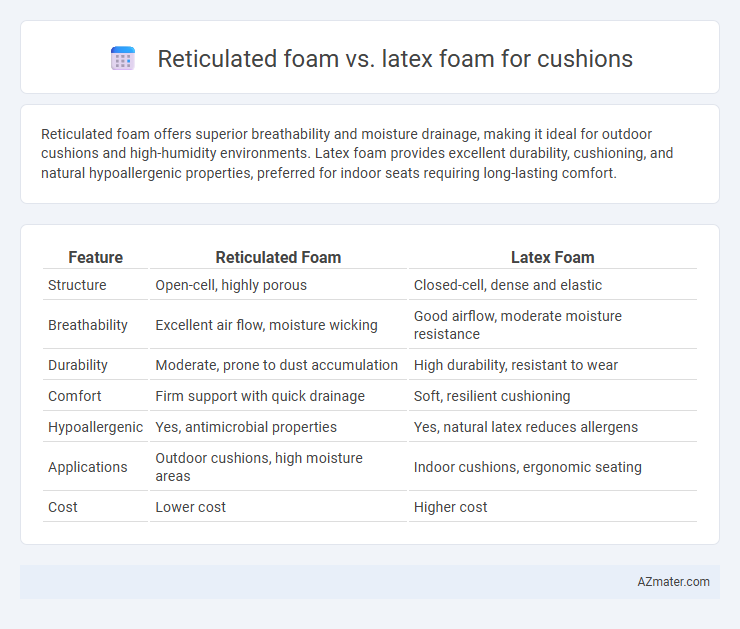Reticulated foam offers superior breathability and moisture drainage, making it ideal for outdoor cushions and high-humidity environments. Latex foam provides excellent durability, cushioning, and natural hypoallergenic properties, preferred for indoor seats requiring long-lasting comfort.
Table of Comparison
| Feature | Reticulated Foam | Latex Foam |
|---|---|---|
| Structure | Open-cell, highly porous | Closed-cell, dense and elastic |
| Breathability | Excellent air flow, moisture wicking | Good airflow, moderate moisture resistance |
| Durability | Moderate, prone to dust accumulation | High durability, resistant to wear |
| Comfort | Firm support with quick drainage | Soft, resilient cushioning |
| Hypoallergenic | Yes, antimicrobial properties | Yes, natural latex reduces allergens |
| Applications | Outdoor cushions, high moisture areas | Indoor cushions, ergonomic seating |
| Cost | Lower cost | Higher cost |
Introduction to Cushion Foams
Reticulated foam features an open-cell structure that enhances breathability and drainage, making it ideal for outdoor cushions and high-moisture environments. Latex foam offers superior resilience, natural elasticity, and hypoallergenic properties, providing durable and comfortable support for indoor cushions. Both foams differ significantly in texture, durability, and moisture management, influencing their suitability for various cushioning applications.
What is Reticulated Foam?
Reticulated foam is a highly porous, open-cell polyurethane foam designed to allow maximum airflow and drainage, making it ideal for outdoor cushions, filtration, and sports equipment. Unlike latex foam, reticulated foam undergoes a special process that removes most cell membranes, resulting in a durable, breathable material that resists mold and mildew. Its unique structure provides excellent cushioning support while enhancing ventilation and quick drying properties.
What is Latex Foam?
Latex foam is a natural material derived from the sap of rubber trees, prized for its resilience and hypoallergenic properties in cushions. Unlike reticulated foam, which has an open-cell structure allowing high airflow, latex foam offers a denser, more supportive feel with excellent pressure relief. Its durability and resistance to dust mites make latex foam cushions ideal for long-lasting comfort and health-conscious applications.
Key Differences: Reticulated vs Latex Foam
Reticulated foam features an open-cell structure that enhances breathability and rapid water drainage, making it ideal for outdoor and marine cushions. Latex foam offers superior resilience, natural antimicrobial properties, and enhanced comfort with a denser, closed-cell structure, providing better support and durability for indoor cushioning. The choice between reticulated and latex foam depends on desired ventilation, moisture resistance, and comfort levels tailored to specific cushion applications.
Breathability and Airflow Comparison
Reticulated foam offers superior breathability and enhanced airflow due to its open-cell structure, allowing air to pass freely and moisture to dissipate quickly, making it ideal for cushions in hot or humid environments. Latex foam, while providing excellent support and durability, has a denser structure with less airflow, which can trap heat and reduce breathability compared to reticulated foam. Choosing reticulated foam cushions improves ventilation and comfort, particularly for users seeking cooler seating surfaces.
Comfort and Support Levels
Reticulated foam offers enhanced breathability and firmer support, making it ideal for cushions requiring high durability and ventilation. Latex foam provides superior comfort with its natural elasticity and pressure-relieving qualities, promoting better body contouring and reduced fatigue. Comparing comfort and support levels, latex foam delivers a softer, more adaptive feel, while reticulated foam excels in maintaining structural integrity under weight.
Durability and Longevity
Reticulated foam offers high durability due to its open-cell structure, allowing excellent airflow and quick drying, making it resistant to mold and mildew over time. Latex foam, derived from natural or synthetic rubber, provides superior longevity with its inherent resilience and ability to retain shape despite prolonged compression. Both foams maintain structural integrity well, but latex foam typically outperforms reticulated foam in long-term durability for cushion applications.
Application Suitability
Reticulated foam is highly suitable for outdoor cushions and pool furniture due to its excellent water drainage and quick-drying properties. Latex foam excels in indoor applications, providing superior comfort, durability, and natural resistance to dust mites and mold. Choosing between the two depends on whether moisture resistance or comfort and hypoallergenic qualities are prioritized.
Environmental Impact and Sustainability
Reticulated foam, often made from polyurethane, is less biodegradable and derived from petroleum, leading to a higher environmental footprint compared to natural latex foam, which is harvested from rubber trees and is biodegradable. Latex foam cushions offer superior sustainability due to their renewable resource base and longer product lifespan, reducing waste in landfills. Choosing latex foam supports eco-friendly practices through reduced chemical use and enhanced recyclability, aligning with sustainable cushioning solutions.
Which Foam is Best for Your Cushion?
Reticulated foam offers superior airflow and moisture drainage, making it ideal for outdoor cushions and high-humidity environments, while latex foam provides excellent durability, resilience, and natural antimicrobial properties suited for indoor cushions requiring comfort and longevity. Reticulated foam's open-cell structure enhances breathability and rapid drying, preventing mold and mildew buildup, whereas latex foam's dense, responsive nature delivers consistent support and pressure relief. Choosing the best foam depends on the cushion's intended use: select reticulated foam for ventilation and water exposure, or latex foam for cushioned comfort and durability in everyday indoor settings.

Infographic: Reticulated foam vs Latex foam for Cushion
 azmater.com
azmater.com